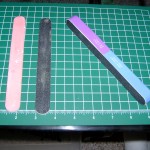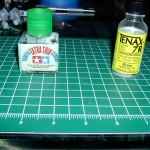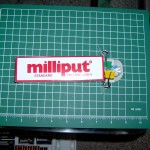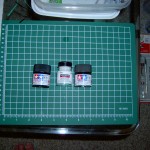Modeling Supplies
THIS IS STILL IN PROGRESS
So one of the big annoyances I have with Gamera’s tutorials are that he has a crap load of all these spiffy tools and toys and he’s like “so then I just pull this flux capacitor out of my ass and now this shield looks like Yutaka Izubuchi himself just built it. In fact, you can see his signature right here.” Great. Next time I’m at your house, bend over so I can have a flux capacitor too.
So I kept all my receipts so I can put together a shopping list of all the crap you will want to buy depending on what step of building you’re in. Also you know what the basic price your looking at is for beginner level tools. And where to get them. And what NOT to waste your money on (like a flux capacitor). Keep in mind, I am not a thrifty person and these are brick-and-mortar retail store prices. You can find all this stuff cheaper if you try, especially online.
Step 1. A work area.
 I model on my coffee table in front of my television so I can be inspired by anime. I have no idea if this will continue once I’m married but I’m enjoying it for the time being. Anyway, you’re occasionally cutting things or using chemicals. You (in theory) want to keep your desk/table clean so I recommend getting a cutting mat. 8.5″ x 12″ cutting mat. $11.99. Any hobby store. Possibly any store with school supplies. If you want to get by on the cheap, you can just work on flat cardboard boxes, a sheet of aluminum or just work someplace where you don’t care if it gets cut up/dirty.
I model on my coffee table in front of my television so I can be inspired by anime. I have no idea if this will continue once I’m married but I’m enjoying it for the time being. Anyway, you’re occasionally cutting things or using chemicals. You (in theory) want to keep your desk/table clean so I recommend getting a cutting mat. 8.5″ x 12″ cutting mat. $11.99. Any hobby store. Possibly any store with school supplies. If you want to get by on the cheap, you can just work on flat cardboard boxes, a sheet of aluminum or just work someplace where you don’t care if it gets cut up/dirty.
 You want some good lighting. I use a “book light” that someone got me for Christmas one year that I never had a reason to use until now. Also make sure you have a roll of paper towels, or some washable rags if you’re a tree hugger. I put a piece over my lap and over the table to hold parts/cleanup/wipe tools.
You want some good lighting. I use a “book light” that someone got me for Christmas one year that I never had a reason to use until now. Also make sure you have a roll of paper towels, or some washable rags if you’re a tree hugger. I put a piece over my lap and over the table to hold parts/cleanup/wipe tools.
Step 2. Cutting from the tree.
 Gamera likes to make fun of people for using nail clippers so I knew to stay away from those. However, don’t show your room temperature IQ like me and buy a pair of needle nose pliers thinking you can just snake it past the parts on the tree and use the wire cutter part. It’s not going to fit. LEFT = good. RIGHT = bad.
Gamera likes to make fun of people for using nail clippers so I knew to stay away from those. However, don’t show your room temperature IQ like me and buy a pair of needle nose pliers thinking you can just snake it past the parts on the tree and use the wire cutter part. It’s not going to fit. LEFT = good. RIGHT = bad.
Both at home depot. The needle nose is still handy so at $2.97 I’d say to pick one up. I use it like a “jaws of life” to open certain parts I can’t fit my fingers in, or to hold really small stuff. The other one I lost the receipt to, but it was like $5.
Step 3. Sanding.
 You also want to pick up some sanding sticks. $1.44 and $4.99 from Target. The $4.99 one has 6 different grains and can get a piece super shiny. Mostly overkill. I’d just get the cheap sticks. Black is rough, and the other has 2 different pinks of higher grit.
You also want to pick up some sanding sticks. $1.44 and $4.99 from Target. The $4.99 one has 6 different grains and can get a piece super shiny. Mostly overkill. I’d just get the cheap sticks. Black is rough, and the other has 2 different pinks of higher grit.
 You also want some different grit sanding papers, I’m using the Mr. Grinding Cloth $7.99 (1000/2000/3000 grit) for wet sanding and Model Master sanding films $7.59. Gamera has another type of sanding cloth he wants me to get that I’ll post up later. All from local hobby store.
You also want some different grit sanding papers, I’m using the Mr. Grinding Cloth $7.99 (1000/2000/3000 grit) for wet sanding and Model Master sanding films $7.59. Gamera has another type of sanding cloth he wants me to get that I’ll post up later. All from local hobby store.

 You’ll want a hobby knife. I just got an Excel Hobby Knife set for $9.49 at the hobby store. I later had to also purchase a Needle Point Hobby Awl for carving sanded away panel lines back into the pieces. $2.99. This isn’t strictly sanding, but you can save yourself some sanding with the knife, and it’s useful for a ton of other crap so go ahead and buy it at this point cause you’re gonna need it.
You’ll want a hobby knife. I just got an Excel Hobby Knife set for $9.49 at the hobby store. I later had to also purchase a Needle Point Hobby Awl for carving sanded away panel lines back into the pieces. $2.99. This isn’t strictly sanding, but you can save yourself some sanding with the knife, and it’s useful for a ton of other crap so go ahead and buy it at this point cause you’re gonna need it.
Step 4. Gluing them together.
If you can find it, buy the Tamiya Extra Thin Cement ($4.99). It comes with a little applicator brush built in. If not, I had to buy Tenax-7R ($3.99). As an applicator for the Tenax I tried a few things. Q-tips are bad. They absorb all the fluid, and are too thick to apply the cement accurately. Also don’t try pipettes. I must have been on crack to try using a plastic squeeze bottle to apply a chemical that melts plastic.. It actually held up well, but then I squeezed too hard and sprayed my piece with Tenax resulting in a gooey mess that I had to putty up and sand back down to fix. I eventually found a good solution for $0.99 at a beauty store. An eyeliner brush. Which is basically just a really fine point paintbrush. The bristles are hair though, and the piece is metal so it stands up well. The hair gets stiff when it dries with the plastic it’s picked up, but next time you dip it, it softens back up real fast. Another cement option is Pro Weld. Micro brushes ($3 for a pack of 10) like in the picture also work well for applicators for both it, and the Tenax.



Big Paper Clips for clamping pieces.

A container to put all your little pieces in so you don’t lose them, or flick one into your air conditioning vent and have to pray it didn’t go all the way down as you pry up the vent to try and get it back out. I got the container with all the tacks, paperclips, and clamps in it from Target for $4.99.
Step 5. Fixing mistakes
 Milliputt. For old crappy models, or just because you got too zealous while sanding, or if you sprayed Tenax all over a piece, you sometimes have to do some repairs. There are other, better, putties for models, but this kind is pretty cheap. $7.95 from Hobby Store.
Milliputt. For old crappy models, or just because you got too zealous while sanding, or if you sprayed Tenax all over a piece, you sometimes have to do some repairs. There are other, better, putties for models, but this kind is pretty cheap. $7.95 from Hobby Store.
Step 6. Priming

 Before you prime, you probably want to degrease those pieces to get all the oil off your fingers and clean off any dust. I just bought a jumbo size of Simple Green from Home Depot $15 and then a air tight food container ($10 Target) to keep it in. Gamera uses it pure, but I did a 50/50 mix with water and then just drop the pieces in over-night.
Before you prime, you probably want to degrease those pieces to get all the oil off your fingers and clean off any dust. I just bought a jumbo size of Simple Green from Home Depot $15 and then a air tight food container ($10 Target) to keep it in. Gamera uses it pure, but I did a 50/50 mix with water and then just drop the pieces in over-night.

For priming you need primer. At first I bought the Mr. Surfacer 1000 on the left for $7.99 at the Hobby Store. It ran out fast, but it’s nice thin stuff. The can on right is Design Master primer 645. It’s a bit thicker but it was only $6.49 at Michaels and has like three times as much stuff.
 You don’t really want to hold the pieces though while you’re priming them. So go to Home Depot and buy some alligator clips. 4 for $1.98 in the electronics aisle. I bought 20, and then clamped them onto bamboo skewers (with my needle-nose pliers! Not useless!). The skewers you can get at any grocery store for a few bucks. You grab onto a piece with the clamp, spray your part, and then stick the skewer into a big block of foam or something until it dries.
You don’t really want to hold the pieces though while you’re priming them. So go to Home Depot and buy some alligator clips. 4 for $1.98 in the electronics aisle. I bought 20, and then clamped them onto bamboo skewers (with my needle-nose pliers! Not useless!). The skewers you can get at any grocery store for a few bucks. You grab onto a piece with the clamp, spray your part, and then stick the skewer into a big block of foam or something until it dries.
Step 7. Painting (Air Brushing)
 While these aren’t absolutely necessary gloves keep your hands pretty. My woman does not like it when my hands are colors that God did not intend them to be. Just buy a box of 100 from Home Depot for $10. You’re all set.
While these aren’t absolutely necessary gloves keep your hands pretty. My woman does not like it when my hands are colors that God did not intend them to be. Just buy a box of 100 from Home Depot for $10. You’re all set.
Blue Painters Masking tape is useful for a bunch of things. I used it to strip off primer that didn’t have a good grip on the pieces. Normally you use it to “mask” your pieces while painting. Which is a good thing since it matches the name of the tape. $4 at Home Depot.
 The smaller stuff on the right is Tamiya Masking Tape (6mm) which was $5 at the hobby store. The Blue stuff is great for masking big area, but it doesn’t get as good of a seal. The Tamiya is really small but gets a good seal on the plastic so your paint won’t leak under it. Use the Tamiya to do all the detail spots, and then cover the big areas with the cheap blue stuff.
The smaller stuff on the right is Tamiya Masking Tape (6mm) which was $5 at the hobby store. The Blue stuff is great for masking big area, but it doesn’t get as good of a seal. The Tamiya is really small but gets a good seal on the plastic so your paint won’t leak under it. Use the Tamiya to do all the detail spots, and then cover the big areas with the cheap blue stuff.
Air Brush Supplies that I have pics for but no text yet.
Consolidated Shopping List
Okay, so if you’re lazy and just want to get all the basic stuff that you want for a kit, here you go. Remember the prices are like average, so you can get cheaper (or more expensive) as you like.
Basic list for building
- Nippers – $5
- Sanding Pads – $5 to $20
- Hobby Knife – $10
- Cement/Tenax – $5
- Primer – $9
- Putty – $10
- Cutting Mat – $12
- Sanding Sticks – $3
- High Grit Sand Paper for Wet Sanding – $10
- Clamps – $4
Optional
Basic list for air brushing
- Air Brush + Connectors
- Air Can
- Acrylic Paints
- Paint Thinner/Isopropal Alcohol
- Future Floor Polish
- Primer – $6 to $8
- Masking Tape – $4
- Simple Green – $15
- Container to store it – $10
- Latex/Vinyl Disposable Gloves – $10
- Bamboo Skewers – $5 and Aligator Clips – $10
- Big Block of Foam, or Wood with Holes drilled in it
Optional:
Hobby Stores Near Germantown
Hobby Town – Frederick
Hobby Works – Rockville
KB Toys – Gaithersburg
Home Depot, Target, Michaels, etc are everywhere.




